|
The Soldiers National Cemetery
Soldiers National Cemetery at Gettysburg
| The Soldiers National Monument |
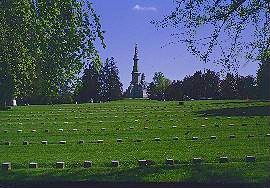
|
| Gettysburg NMP |
Gettysburg National Cemetery
One of the first truly "national" cemeteries, the Soldiers National Cemetery is located adjacent to Evergreen
Cemetery on the southern edge of Gettysburg. The dedication of the burial ground was the setting for President Abraham Lincoln's most well known and revered speech, the Gettysburg Address, which he delivered on November 19, 1863. The site of the cemetery was chosen for its scenic view of the South
Mountains west of Gettysburg and because of its importance as a key position in the Union line during the battle. Monuments,
markers, and cannon to Union regiments and batteries located throughout the cemetery remind visitors that the cemetery is
also part of the battlefield. A total of 3,512 bodies of Union soldiers were interred in the cemetery grounds after the battle,
of which 979 are unknown as to name or unit. The Soldiers National Cemetery was transferred to Federal authority soon after
it was completed and was administered by the United States War Department until 1933, when it was transferred to the National
Park Service. Today the cemetery and cemetery annex have 6,000+ burials from all of America's wars.
As the armies moved away from Gettysburg, the residents of Adams County were
shocked to find what had been left behind- thousands of graves scattered in farmyards, fields, and gardens surrounding Gettysburg.
Approximately 6,000 Union and Confederate dead were buried on or near the battlefield. Mortally wounded men died in field
hospitals daily, adding more and more to temporary cemeteries laid out near farm buildings and homes where they had breathed
their last. Many of the burials, especially those on the battlefield, had been done with haste. Heavy rains throughout July
washed away the loose soil, exposing the decaying bodies. Remnants of a hand, foot, or head sticking out of the ground became
a common sight and the accompanying odor hung like a pall over the land. Never before had the population of Adams County been
so affected by the war and experienced so much death and suffering.
| David McConaughy |

|
| Adams Co. H.S. |
The terrible condition of field burials inspired a Gettysburg resident named David McConaughy to take action.
The Gettysburg lawyer and newspaper editor passionately argued that the defenders of the Union cause should have an honorable,
proper burial and not poorly marked shallow graves scattered in farm fields and woods. There should be a cemetery where the
Northern dead could rest in peace, their graves preserved in honor of their sacrifice.
David Wills, another Gettysburg attorney, believed the Union cemetery project a worthwhile cause and though
he spoke with McConaughy about the plan, different philosophies on cemetery design, location, and funding fueled a conflict
between the two. For a brief time it appeared that any cemetery project was doomed to failure, but the commonwealth of Pennsylvania
became involved and Wills became the primary agent for the new cemetery at Gettysburg. A frustrated McConaughy dropped his
cemetery proposal, but refused to abandon his idea of preserving a portion of the battlefield as a memorial to the Union dead
and the army in which they served. Within a year, he had established the first organization to preserve a portion of the battlefield
landscape that eventually became Gettysburg National Military Park.
| Gov. Curtin |

|
| "A New Birth Of Freedom" |
Using his political connections to visit Pennsylvania Governor Andrew Curtin, David Wills presented his
plan for a formal cemetery to be established on the battlefield. Curtin was highly impressed with the project and Wills' sincerity.
The governor had visited Gettysburg soon after the battle and was among the many who were disturbed by the terrible conditions
there, thousands of wounded men being cared for in churches, private homes, and farm buildings.
The sight of human remains sticking our of shallow graves sickened the governor who returned to Harrisburg
to ponder what could be done for the people of Adams County and how to tackle this huge problem of the county as a mass graveyard.
Curtin pledged his complete support to Wills' proposal with an appropriation of state funds to begin land purchases and the
process of re-burial in the new cemetery. Thus, the Soldiers National Cemetery came to being.
| David Wills |

|
| Adams Co. H.S. |
Landscape architect William Saunders was hired to design the cemetery, located on land purchased on the
western side of Cemetery Hill. Wills worked tirelessly with Saunders and agents sent from Pennsylvania, New York, and other
northern states who were to investigate the cemetery project and report on the proper disposition of their deceased. Soon
after the site had been laid out and burials began, Wills organized a dedication ceremony initially planned for October of
that year.
Invitations were sent to noted dignitaries and musical groups, and Mr. Edward Everett, a dedicated Unionist
and orator, who would be the featured speaker. Everett suggested the date of the ceremony be pushed back one month so that
he would have time to arrange his speech for this important occasion and Wills made the arrangements. Almost as an afterthought,
an invitation was sent to President Abraham Lincoln to attend the ceremony and perhaps
provide "a few appropriate remarks." Somewhat to the surprise of Wills and his associates, the president agreed to attend.
The National Cemetery Dedication was held on November 19, 1863.
| The National Cemetery, ca. 1910. |
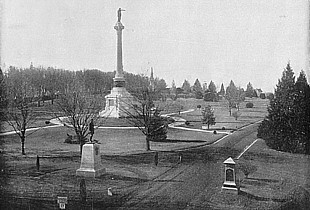
|
| Gettysburg NMP |
The Soldiers' National Cemetery was finally completed in 1869 after the installation of grave markers, a
stone-chipped walk, and the Soldiers National Monument, which stands in the center of the cemetery. Though the Union dead
had been taken care of, the Confederate dead still remained in scattered field burials and hospital sites, including the temporary
cemetery where Camp Letterman had been. Concerned with providing their native sons with a proper burial, ladies' memorial
societies in several southern states secured state monies and donations to have the Southern dead relocated to their home
states.
(Left) The Soldiers National Cemetery in 1910.
The first re-internment of Confederate dead began in 1872, once again performed by Samuel Weaver who had
been in charge of the re-internments in the Gettysburg national cemetery. Carefully boxed and labeled, the remains were shipped
by rail to cemeteries in Savannah, Charleston, and Raleigh. The remaining bodies were to be shipped to Hollywood Cemetery
in Richmond, Virginia, where a special section was set aside specifically for this purpose. The boxes of remains, some containing
as many as five in each, were set side by side in the designated plot as they arrived. The last of these reburials was completed
by 1877.
| New York Monument |
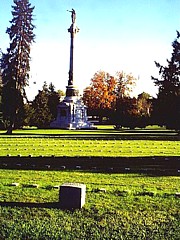
|
| Gettysburg NMP |
Today the Soldiers National Cemetery is one of the most honored and visited sites in Gettysburg National
Military Park. In the center of the cemetery stands the Soldiers National Monument, erected in 1869 as a national memorial
of sorrow. Marble statues around the base of the monument, carved by the famous sculptor Randolph Rogers, represent four chapters
of time- history, war, peace and plenty. Atop the monument is the figure of Liberty who holds a sword in one hand and the
wreath of peace in the other, representing the constant struggle for freedom. Also in the National Cemetery is the New York
State Monument (at left), placed here because of that state's sacrifice during the campaign. More New York soldiers died or
were injured at Gettysburg than from any other Union state. This towering monument, one of the tallest in the park, stands
in the northern end of the cemetery and is adorned with bronze reliefs that depict certain events of the battle. The symbols
for each of the army corps in the Army of the Potomac also adorn the monument, which was dedicated on July 2, 1893, with a grand ceremony that included many veterans
of the battle, including former general Daniel Sickles. Also in the cemetery are monuments and markers to several Union infantry
regiments and artillery units that were stationed here during the battle, the silent guns now overlooking the serene cemetery
grounds.
| The cemetery entrance on Baltimore Street. |
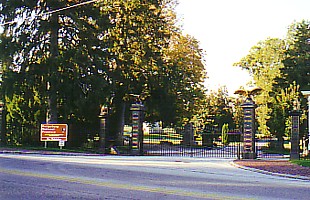
|
| Gettysburg NMP |
Visitors to the cemetery will find two other unique monuments including the Lincoln Speech Memorial, which
memorializes the Gettysburg Address. Dedicated in January 1912 to commemorate President Abraham Lincoln's famous speech, the
memorial bears a striking likeness of the president sculpted by Henry K. Bush-Brown, who also sculpted three equestrian monuments.
Just inside the north gate of the cemetery is the bronze statue to Major General John F. Reynolds who was killed at Gettysburg.
General Reynolds is remembered at Gettysburg with three monuments dedicated to his memory- this statue in the cemetery, a
marker on the location where he was killed on July 1, 1863, and an equestrian statue on Rt. 30 West of Gettysburg. Also in
the cemetery is a monument to the 1st Minnesota Infantry, placed within the Minnesota plot. It is one of the earliest monuments
erected at Gettysburg, placed here before the cemetery was formally completed in 1869.
| William Miller's grave. |
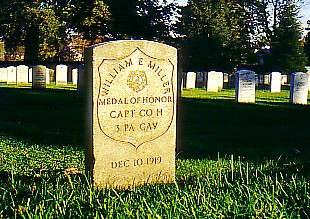
|
| Gettysburg NMP |
Among the honored burials is Captain William A. Miller of the 3rd Pennsylvania Cavalry. Captain Miller,
who died in 1919, received the Congressional Medal of Honor for gallantry in action at the Battle of Gettysburg. He is interred
in one the outer lying sections of the National Cemetery.
Interred in the Ohio section is Private George Nixon, Company B, 73rd Ohio
Infantry, the great-grandfather of former president Richard M. Nixon. Mr. Nixon paid a visit to his ancestor's grave while
he was vice president during the 1950s.
Also buried in the cemetery is Colonel Charles Collis, the former commander
of the 114th Pennsylvania Infantry, also known as "Collis' Zouaves". Though Colonel Collis was not with his regiment at Gettysburg,
be became enamored with the battlefield and enjoyed the area so much that he built a summer home here, which he called "Red
Patch". The house still stands on West Confederate Avenue.
Remarkably, burial in the cemetery of Gettysburg dead has continued up until the 1990s. Among its many relics,
the Rosensteel Collection of Civil War artifacts included human remains found on the battlefield and at field hospital sites
long after the end of the war. These were gathered and buried in a single grave in the cemetery in 1991, followed in 1995
by the burial of a soldier's skeleton recovered from the first day's battlefield. A special detail from the 3rd United States
Infantry acted as honor guard at both events.
"A simple design..."
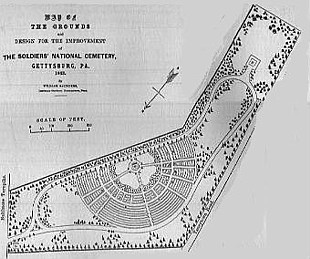
|
| Gettysburg NMP |
The Soldiers' National Cemetery was designed by William Saunders, a
noted landscape architect and gardener, employed with the US Department of Agriculture in Philadelphia. Saunders' designs
for city parks and recreational grounds, such as Hunting Park in Philadelphia, brought him acclaim. In the weeks after the
battle, he was asked to assist attorney David Wills in planning the new cemetery at Gettysburg, which would be a challenge
as every Northern state that lost native sons at Gettysburg had assigned state agents and commissions to oversee the burials
and cemetery design. "I was pleased with the site," Saunders wrote. "On my first visit I studied the ground thoroughly and
thought of various methods of treatment. It occurred to me... and I felt it all important under the plan that the remains
of the soldiers from each State should be laid together in a group. In fact, I had examined the ground before suggesting an
addition to it and had employed an evening considering how best to arrange for interments." Saunders' simple design arranged
burial plots, each distinguished by the state from which the men served, in a semi-circular pattern around a central point.
It was here that a symbolic monument would be erected, the "Soldiers' National Monument" that would signify the backgrounds,
service, sacrifice, and place in time of the fallen. The headstones were designed to be curved granite markers inscribed with
the names and regiments of the dead, placing no special distinction between officers and enlisted men except for a note of
their rank.
The movement of bodies to the cemetery began in the fall of 1863. As
the burials progressed, Saunders took special interest in the final layout of the plots
before returning to his office in Philadelphia. The burials were completed in 1864 and landscape work began in earnest with
walkways and an avenue constructed and grass seeded over the grounds. After the war, Saunders landscaped the grounds of the
Lincoln Tomb at Springfield, Illinois, and founded the National Grange in 1867. Another of his more notable landscape designs
was the campus of Illinois State University in Normal, Illinois. The cemetery at Gettysburg remains one of his greatest works.
See also Pennsylvania Civil War History.
Credit: National Park Service, Gettysburg National Military Park
Recommended Reading: Gettysburg: A Testing of Courage. Description: America's Civil War raged for more than four years, but it is the three days of fighting in the Pennsylvania countryside in July 1863 that continues to fascinate, appall, and inspire new
generations with its unparalleled saga of sacrifice and courage. From Chancellorsville, where General Robert E. Lee launched
his high-risk campaign into the North, to the Confederates' last daring and ultimately-doomed act, forever known as Pickett's
Charge, the battle of Gettysburg gave the Union army a victory that turned back the boldest and perhaps greatest chance for
a Southern nation. Continued below...
Now, acclaimed
historian Noah Andre Trudeau brings the most up-to-date research available to a brilliant, sweeping, and comprehensive history
of the battle of Gettysburg that sheds fresh light on virtually every aspect of it. Deftly balancing his own
narrative style with revealing firsthand accounts, Trudeau brings this engrossing human tale to life as never before.
Advance to:
Recommended Reading: General Lee's
Army: From Victory to Collapse. Review: You cannot say that University of North Carolina
professor Glatthaar (Partners in Command) did not do his homework in this massive examination of the Civil War–era lives
of the men in Robert E. Lee's Army of Northern Virginia. Glatthaar spent nearly 20 years examining and ordering primary source
material to ferret out why Lee's men fought, how they lived during the war, how they came close to winning, and why they lost.
Glatthaar marshals convincing evidence to challenge the often-expressed notion that the war in the South was a rich man's
war and a poor man's fight and that support for slavery was concentrated among the Southern upper class. Continued below...
Lee's army
included the rich, poor and middle-class, according to the author, who contends that there was broad support for the war in
all economic strata of Confederate society. He also challenges the myth that because Union forces outnumbered and materially
outmatched the Confederates, the rebel cause was lost, and articulates Lee and his army's acumen and achievements in the face
of this overwhelming opposition. This well-written work provides much food for thought for all Civil War buffs.
Recommended Reading: ONE CONTINUOUS FIGHT: The Retreat from Gettysburg and the Pursuit of Lee's Army of Northern Virginia, July
4-14, 1863 (Hardcover). Description: The
titanic three-day battle of Gettysburg left 50,000 casualties
in its wake, a battered Southern army far from its base of supplies, and a rich historiographic legacy. Thousands of books
and articles cover nearly every aspect of the battle, but not a single volume focuses on the military aspects of the monumentally
important movements of the armies to and across the Potomac River. One Continuous Fight:
The Retreat from Gettysburg and the Pursuit of Lee's Army
of Northern Virginia, July 4-14, 1863 is the first detailed military history of Lee's retreat and the Union effort to catch
and destroy the wounded Army of Northern Virginia. Against steep odds and encumbered with thousands of casualties, Confederate
commander Robert E. Lee's post-battle task was to successfully withdraw his army across the Potomac River. Union commander
George G. Meade's equally difficult assignment was to intercept the effort and destroy his enemy. The responsibility for defending
the exposed Southern columns belonged to cavalry chieftain James Ewell Brown (JEB) Stuart. If Stuart fumbled his famous ride
north to Gettysburg, his generalship during the retreat more
than redeemed his flagging reputation. The ten days of retreat triggered nearly two dozen skirmishes and major engagements,
including fighting at Granite Hill, Monterey Pass,
Hagerstown, Williamsport, Funkstown,
Boonsboro, and Falling Waters. Continued below...
President Abraham
Lincoln was thankful for the early July battlefield victory, but disappointed that General Meade was unable to surround and
crush the Confederates before they found safety on the far side of the Potomac. Exactly what Meade did to try to intercept the fleeing Confederates, and how the
Southerners managed to defend their army and ponderous 17-mile long wagon train of wounded until crossing into western Virginia on the early morning of July 14, is the subject of this study.
One Continuous Fight draws upon a massive array of documents, letters, diaries, newspaper accounts, and published primary
and secondary sources. These long-ignored foundational sources allow the authors, each widely known for their expertise in
Civil War cavalry operations, to describe carefully each engagement. The result is a rich and comprehensive study loaded with
incisive tactical commentary, new perspectives on the strategic role of the Southern and Northern cavalry, and fresh insights
on every engagement, large and small, fought during the retreat. The retreat from Gettysburg
was so punctuated with fighting that a soldier felt compelled to describe it as "One Continuous Fight." Until now, few students
fully realized the accuracy of that description. Complimented with 18 original maps, dozens of photos, and a complete driving
tour with GPS coordinates of the entire retreat, One Continuous Fight is an essential book for every student of the American
Civil War in general, and for the student of Gettysburg in
particular. About the Authors: Eric J. Wittenberg has written widely on Civil War cavalry operations. His books include Glory
Enough for All (2002), The Union Cavalry Comes of Age (2003), and The Battle of Monroe's Crossroads and the Civil War's Final
Campaign (2005). He lives in Columbus, Ohio.
J. David Petruzzi is the author of several magazine articles on Eastern Theater cavalry operations, conducts tours of cavalry
sites of the Gettysburg Campaign, and is the author of the popular "Buford's Boys." A long time student of the Gettysburg
Campaign, Michael Nugent is a retired US Army Armored Cavalry Officer and the descendant of a Civil War Cavalry soldier. He
has previously written for several military publications. Nugent lives in Wells, Maine.
Recommended Reading: Gettysburg,
by Stephen W. Sears (640 pages) (November 3, 2004). Description: Sears delivers another masterpiece with this comprehensive study of America’s most studied Civil War battle. Beginning with Lee's meeting with
Davis in May 1863, where he argued in favor of marching north, to take pressure off both Vicksburg and Confederate logistics. It ends with the battered Army
of Northern Virginia re-crossing the Potomac just two months later and with Meade unwilling to drive his equally battered
Army of the Potomac into a desperate pursuit. In between is the balanced, clear and detailed
story of how tens-of-thousands of men became casualties, and how Confederate independence on that battlefield was put forever
out of reach. The author is fair and balanced. Continued below...
He discusses the shortcomings of Dan Sickles, who
advanced against orders on the second day; Oliver Howard, whose Corps broke and was routed on the first day; and Richard Ewell,
who decided not to take Culp's Hill on the first night, when that might have been decisive. Sears also makes a strong argument
that Lee was not fully in control of his army on the march or in the battle, a view conceived in his gripping narrative of
Pickett's Charge, which makes many aspects of that nightmare much clearer than previous studies. A must have for the Civil
War buff and anyone remotely interested in American history.
Recommended Reading: Retreat from Gettysburg:
Lee, Logistics, and the Pennsylvania Campaign (Civil War America) (Hardcover). Description: In a groundbreaking, comprehensive history of the Army of Northern Virginia's retreat
from Gettysburg in July 1863, Kent Masterson Brown draws on
previously unused materials to chronicle the massive effort of General Robert E. Lee and his command as they sought to expeditiously
move people, equipment, and scavenged supplies through hostile territory and plan the army's next moves. More than fifty-seven
miles of wagon and ambulance trains and tens of thousands of livestock accompanied the army back to Virginia. Continued
below...
The movement
of supplies and troops over the challenging terrain of mountain passes and in the adverse conditions of driving rain and muddy
quagmires is described in depth, as are General George G. Meade's attempts to attack the trains along the South Mountain range and at Hagerstown and Williamsport, Maryland. Lee's deliberate pace, skillful
use of terrain, and constant positioning of the army behind defenses so as to invite attack caused Union forces to delay their
own movements at critical times. Brown concludes that even though the battle of Gettysburg
was a defeat for the Army of Northern Virginia, Lee's successful retreat maintained the balance of power in the eastern theater
and left his army with enough forage, stores, and fresh meat to ensure its continued existence as an effective force.
Recommended Reading: Lincoln
at Gettysburg: The Words that Remade America
(Simon & Schuster Lincoln Library). Description: The power
of words has rarely been given a more compelling demonstration than in the Gettysburg Address. Lincoln was asked to memorialize the gruesome battle. Instead he gave the whole nation "a
new birth of freedom" in the space of a mere 272 words. His entire life and previous training and his deep political experience
went into this, his revolutionary masterpiece. Continued below...
By examining both the address and Lincoln in their historical moment and cultural frame, Wills
breathes new life into words we thought we knew, and reveals much about a president so mythologized but often misunderstood.
Wills shows how Lincoln desired to change the world and…how his words had to and did
complete the work of the guns, and how Lincoln wove a spell
that has not yet been broken.
|

